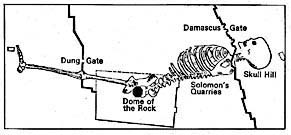The
four Evangelists say that Jesus was crucified in a place called the "Skull"
(in Hebrew, Golgotha, in Latin, Calvary). The name was probably used at
the time to indicate the summit of a hill in the shape of a skull. Another
version of the story (dating back to medieval times) is that the "skull"
referred to is Adam's, and that Adam was buried right below Jesus Christ's
cross. In 1883 Gordon, the British general who had distinguished himself
in the famous battle of Khartoum, arrived in Jerusalem with a Bible and
some strange measuring instruments.
Gordon studied the topography of Jerusalem and concluded that the Holy
Sepulchre, venerated by Christians for over 1,500 years, was a fake. In
fact, Gordon developed an extraordinary theory based on the fact that
the hills running parallel to the Kidron Valley and to the Mount of Olives
looked like a human skeleton. 
The skull of the skeleton
lay on a hill outside the city walls next to a Muslim cemetery, and that
is where Gordon placed the location of the Calvary . Gordon even proved
that the form of a skull, with two eyes and the mouth on the rock below
the cemetery, was visible on the hill. Next to the "skull" lay an ancient
tomb hewn in the stone, which had been discovered accidentally in 1867;
this was the final proof of Gordon's theory. Today, more than one hundred
years later, the Skull Hill site is a magnificent garden with blossoming
flowerbeds and manicured paths. The visitor is invited to tour the site
and see the evidence of Gordon's theory for himself.
Skull Hill
